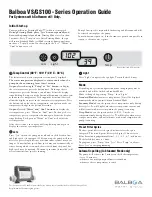
Page 41
XPG20 SERIES
from the unit and periodically check for debris which
collects around the unit.
When removing debris from around the unit, be aware
of metal edges on parts and screws. Although special
care has been taken to keep exposed edges to a
minimum, physical contact with metal edges and
corners while applying excessive force or rapid motion
can result in personal injury.
Cleaning of the outdoor unit’s coil should be performed
by a trained service technician. Contact your dealer
and set up a schedule (preferably twice a year, but at
least once a year) to inspect and service your heat
pump system.
HEAT PUMP OPERATION
Your new Lennox heat pump has several characteristics
that you should be aware of:
S
Heat pumps satisfy heating demand by delivering
large amounts of
warm
air into the living space. This
is quite different from gas- or oil-fired furnaces or an
electric furnace which deliver lower volumes of
considerably
hotter
air to heat the space.
S
Do not be alarmed if you notice frost on the outdoor coil
in the winter months. Frost develops on the outdoor
coil during the heating cycle when temperatures are
below 45
°
F (7
°
C). An electronic control activates a
defrost cycle lasting 5 to 15 minutes at preset intervals
to clear the outdoor coil of the frost.
S
During the defrost cycle, you may notice steam rising
from the outdoor unit. This is a normal occurrence. The
thermostat may engage auxiliary heat during the
defrost cycle to satisfy a heating demand; however,
the unit will return to normal operation at the
conclusion of the defrost cycle.
EXTENDED POWER OUTAGE
The heat pump is equipped with a compressor crankcase
heater which protects the compressor from refrigerant
slugging
during cold weather operation.
If power to your unit has been interrupted for several hours
or more, set the room thermostat selector to the
EMERGENCY HEAT setting to obtain temporary heat
without the risk of serious damage to the heat pump.
In EMERGENCY HEAT mode, all heating demand is
satisfied by auxiliary heat; heat pump operation is locked
out. After a six-hour compressor crankcase warm-up
period, the thermostat can be switched to the HEAT setting
and normal heat pump operation may resume.
THERMOSTAT OPERATION
Though your thermostat may vary somewhat from the
description below, its operation will be similar.
1.
Temperature Setting Levers
Most heat pump thermostats have two temperature
selector levers: one for heating and one for cooling.
Set the levers or dials to the desired temperature
setpoints for both heating and cooling. Avoid frequent
temperature adjustment; turning the unit off and back
on before pressures equalize puts stress on the unit
compressor.
2.
Fan Switch
In AUTO or INT (intermittent) mode, the blower
operates only when the thermostat calls for heating or
cooling. This mode is generally preferred when
humidity control is a priority. The ON or CONT mode
provides continuous indoor blower operation,
regardless of whether the compressor or auxiliary heat
are operating. This mode is required when constant air
circulation or filtering is desired.
3.
System Switch
Set the system switch for heating, cooling or auto
operation. The auto mode allows the heat pump to
automatically switch from heating mode to cooling
mode to maintain predetermined comfort settings.
Many heat pump thermostats are also equipped with
an emergency heat mode which locks out heat pump
operation and provides temporary heat supplied by the
auxiliary heat.
4.
Indicating Light
Most heat pump thermostats have an amber light
which indicates when the heat pump is operating in the
emergency heat mode.
5.
Temperature Indicator
The temperature indicator displays the actual room
temperature.
PROGRAMMABLE THERMOSTATS
Your Lennox system may be controlled by a
programmable thermostat. These thermostats provide the
added feature of programmable time-of-day setpoints for
both heating and cooling. Refer to the user’s information
manual provided with your particular thermostat for
operation details.
PRESERVICE CHECK
If your system fails to operate, check the following before
calling for service:
S
Check to see that all electrical disconnect switches are
ON.
S
Make sure the room thermostat Temperature Selector
and System Switch (Heat, Cool, Auto) are properly
set.
S
Check for any blown fuses or tripped circuit breakers.
S
Make sure unit access panels are in place.
S
Make sure air filter is clean.
S
If service is needed, locate and write down the unit
model number and have it handy before calling.
OPTIONAL ACCESSORIES
Optional accessories for the XPG20 include the following:
S
Low ambient kit
S
Snow Guard − X8782
S
Snow Shield Kit − 44W14
NOTE
S
ee the
XPG20
Engineering Handbook for more
details.



































